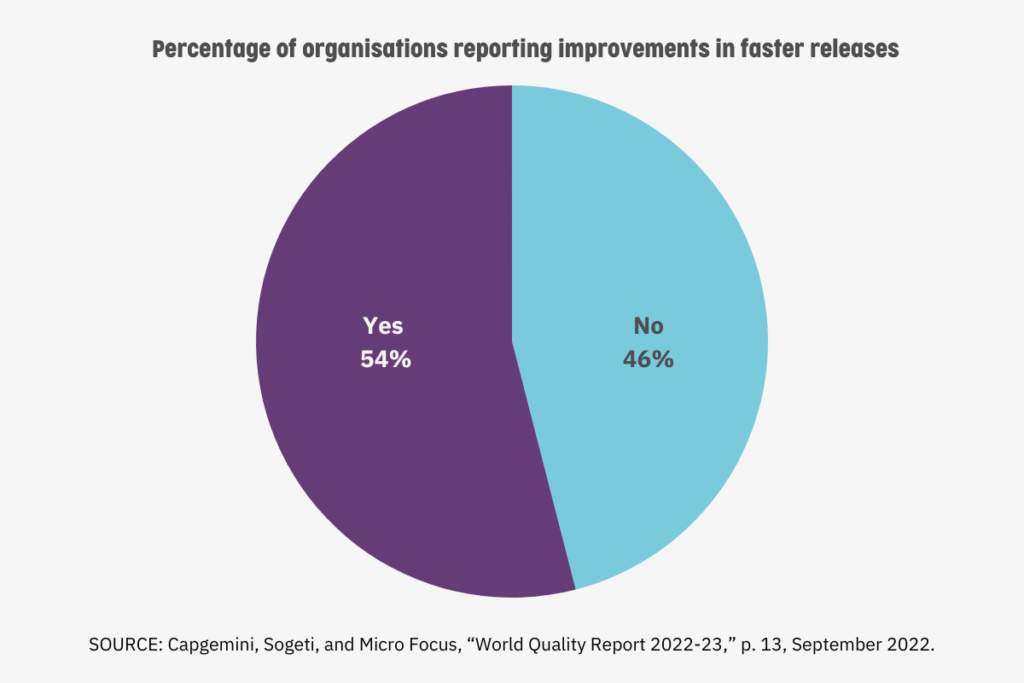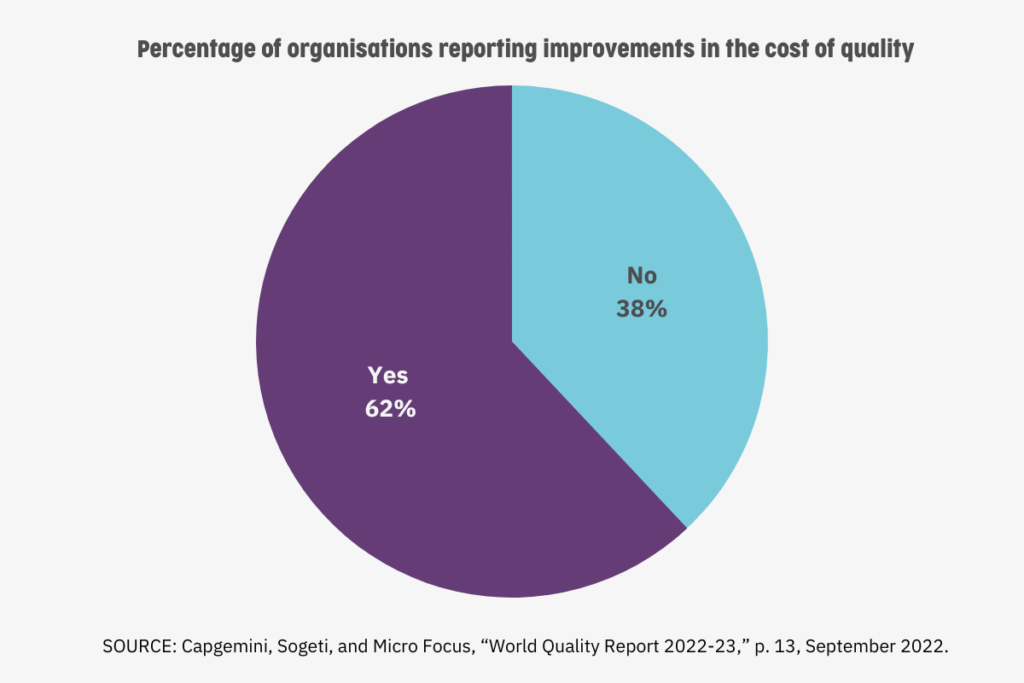Four ways test engineers add value to every project
Our test engineers are essential to the success of every project. In this blog post, Senior Test Engineer Bianca explains how our testers bring value to Bluefruit and its clients.
The latest World Quality Report, an assessment of quality assurance practices worldwide, found that companies investing in Agile testing gain several important advantages. These include better software quality and reliability, faster delivery times, and greater customer satisfaction.
At Bluefruit, testing is an essential part of our software development process, deeply rooted in our Lean-Agile way of working. Many of our technical practices, such as Test-Driven Development (TDD) and Behaviour-Driven Development (BDD), are centred around it.
We believe that testing early and often is one of the reasons we produce such high-quality software.
1. Improving quality
The World Quality Report states 56% of companies employing Agile testing methods experience significantly better quality.
At Bluefruit, our test engineers are involved at all stages of a project. They collaborate with clients, analysts, designers, and developers to ensure that we build what our clients want and that we build it to the highest standard.

At a basic level, test engineers write, execute, and maintain tests to validate the software’s functionality and identify defects. We are always thinking about how end-users will interact with the software, how they could use it, and how they should use it. By considering everything that could go wrong, even if it’s unlikely, we ensure it doesn’t go wrong when it matters the most.
Test engineers are often perfectionists. Making sure that our teams produce the highest quality software is what drives us.
One of our main tasks is to validate requirements to be clear and complete. This way, everybody involved in the project is on the same page, and we can build a product that truly meets the users’ needs. We write tests that cover all the functionalities of the product based on those requirements. Then we prioritise testing efforts based on potential risks so that we can address the most critical issues first.
Tests are conducted each time the developer implements a change–not just when they are ready to be released to the client:
- Regression testing allows us to check whether new changes have introduced defects in other areas of the software.
- Performance testing is used to assess the efficiency of the product.
- Exploratory testing looks beyond the written specifications. It uses the knowledge we’ve gained during the project and our prior experience to explore potential defects.
- Security testing identifies and fixes vulnerabilities in software applications. It helps to ensure that applications are secure and that user data is protected.
- Usability testing examines how users interact with the product to identify any problems with the controls, instructions or interface.
Through diligent testing, we gain a high level of confidence in the quality of the software. This is especially important for medical products where defects could lead to harm or even death. Such products cannot be launched without extensive testing, as seen in our medical diagnostic device case study.
2. Reducing risk
How can prioritising testing reduce risk?
Testing earlier in a project finds defects that might otherwise go unnoticed until the end. Working closely with the team, a fast feedback loop ensures that defects are fixed while the code is still fresh in their minds and easier to correct.
When we have written our tests for requirements and previous defects, we can use these in regression test suites. These regression suites run regularly when the code changes, ensuring no defects are inadvertently added. The World Quality Report found that 63% of Agile organisations reported improved predictability.
With fewer surprises discovered later in the project, organisations also reported a reduced risk of missing deadlines; 64% reported improvements in delivering on time.
3. Reducing time-to-market
In the World Quality Report, 54% of organisations believed that Agile testing leads to faster releases.
As part of our Lean-Agile approach, we work in two-week increments called Sprints. At the end of each Sprint, we deliver tested software releases to our clients. They give us feedback, and we adjust as needed. These short bursts of work offer great opportunities to address any concerns quickly and to constantly improve as we progress.

We test early, often, and thoroughly. This enables us to find and fix any issues that may cause delays, helps us speed up the time-to-market, and meet any deadlines.
Test automation further improves productivity.
We write our tests using Gherkin, a human-readable language with a simple structure, which we can easily automate. Automating tests allows us to cover more functionality in less time. And we can run them repeatedly, which is useful for regression testing. This frees us to do other valuable testing, such as exploratory, performance, security, or usability testing.
Faster and more thorough testing means we can deal with issues more effectively, adding extra value to the project.
Testers often have the broadest project knowledge within the team. Analysts focus on capturing and communicating the client’s needs. Developers think about the individual components required to meet those needs. But testers look at the software as a whole, finding gaps in the requirements and issues in the software. We work closely with everybody on the team to help accelerate the development process, improving collaboration.
Our Lean-Agile testing practices speed up project delivery through short feedback loops.
This is how we helped one of our clients receive FDA approval on a medical device while working under a tight timeline.
4. Increasing profitability
The World Quality Report shows that 61% of companies that practice Agile testing see a significant improvement in customer experience.
Our testers verify that products meet user needs and expectations. We look for and deal with issues that would otherwise worsen the user experience.
Thorough testing and a strong user focus can lead to a loyal client base and a new market footing.
The level of testing that we do makes products more reliable and more pleasant to use. This can lead to greater customer satisfaction, a better reputation, and more sales. We can also help find areas for improvement that could give the product a competitive edge. The World Quality Report findings confirm this, with 62% of organisations agreeing that the cost of quality is reduced.

Our close collaboration with ELGA LabWater is a good example of how user consideration and comprehensive testing can make a project more successful.
It’s results like these that make our test engineers passionate about their jobs. We love looking for defects, and we do so as soon as possible. The sooner that we test, the sooner that we find bugs. This way, developers can fix them before they become bigger problems that are more complex and more expensive to solve. Tackling these problems earlier means avoiding costly rework and reducing maintenance costs overall. This also allows us to assess risks so that we may reduce them before they can lead to failure.
These are just some of the things that our testers do to add value to every project that comes our way. If you’d like to learn more about what test engineers do at Bluefruit, read our post on software test engineer responsibilities.
Are you looking to develop a new product or have an existing one?
Bluefruit Software has been providing high-quality embedded software engineering and testing services for more than 22 years. Our team of experienced engineers, testers and analysts has worked with a diverse range of clients and industries, including medical, scientific instruments, aerospace, automotive, consumer and more.
We can help you with software development at any project stage, ensuring quality, reliability, and security. Contact us today to discuss your software development needs.
Did you know that we have a monthly newsletter?
If you’d like insights into software development, Lean-Agile practices, advances in technology and more to your inbox once a month—sign up today!
Find out more